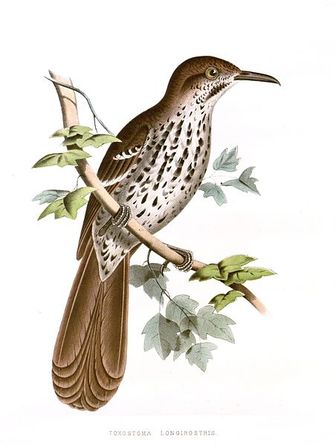Long-billed thrasher
It is slender and long-tailed, averaging 26.5–29 cm in length

The Long-billed thrasher is classified as Least Concern. Does not qualify for a more at risk category. Widespread and abundant taxa are included in this category.
The Long-billed Thrasher (Toxostoma longirostre) is a medium-sized resident songbird of South Texas and eastern Mexico. It is slender and long-tailed, averaging 26.5–29 cm (10.5–11.5 in) in length and about 70 g (2.5 oz) in weight. Adults are brown above with a brighter rufous tinge on the rump and tail, off-white below with a black streak on each side of the throat (the malar) and heavy black streaks on the breast and belly, especially the sides of the breast. There are two pale wingbars. More
A resident of dense brushy habitats, the Long-billed Thrasher is found only in southern Texas and eastern Mexico. It closely resembles its rustier relative, the Brown Thrasher, which spends the winter in some of the same areas. More
Although often heard, Long-billed Thrashers may stay hidden for long periods. During the breeding season, males may be spotted singing from treetops; sometimes heard “thrashing” while foraging on forest floor. Habitat: Long-billed Thrashers require fairly large tracts of dense woodland habitat. Best Spots: Found in forested areas (and feeding stations) at Bentsen SP, Santa Ana NWR, Sabal Palm Grove, and Laguna Atascosa NWR. Similar Species: Most closely resembles Brown Thrasher, a rare migrant and winter visitor to the Valley. More
Bent Life History for the Long-billed Thrasher - the common name and sub-species reflect the nomenclature in use at the time the description was written. (now Long-billed Thrasher) SENNETT'S THRASHER TOXOSTOMA LONGIROSTRE SENNETTI (Ridgway) HABITS Sennett's thrasher was once supposed to be a variety of our common brown thrasher, which it superficially resembles, but it is now recognized as a northern race of a Mexican species. More
Long-billed Thrasher: Resident in south-central Texas and northeastern Mexico. Found in dense tangles and thickets in both open country and wooded areas. Listen to Call Voice Text "tsuck", "kleak", "cheeooep" Interesting Facts * The Long-billed Thrasher has a long and complicated song like other thrashers and mockingbirds, but it is not known to include mimicry in its repertoire. More
The Long-billed Thrasher is rufous-brown above, white below with blacks streaks and has a curved bill and a long tail. It is similar to the Brown Thrasher, but darker and grayer on the head and face, has a longer bill and an orange, not yellow, eye. The song of the Long-billed Thrasher is a varied series of paired phrases similar to those of the Brown Thrasher and its call a low chuck. More
The Long-billed Thrasher (Toxostoma longirostre) is found only in South Texas. This thrasher uses its long decurved bill to forage for food on the ground. Both the male and female have a similar appearence. The Long-billed Long-billed Thrasher Thrasher a rufous crown, nape and upperparts, a gray face and orange eye. Its underparts are white, heavily streaked with black, the wings have white bars and the tail is long and rufous. More
comparison with a Long-billed Thrasher (!) also present in the grove. Brown Thrasher, Tawas Point, MI, 5/05. Brown Thrasher, Tawas Point, MI, 5/05. Long-billed Thrasher, El Paso County, Colorado (!), 1/28/06. Colorado's 3rd record. See Brown Thrasher that was also present in the grove for comparison. Long-billed Thrasher, El Paso County, Colorado (!), 1/28/06. The bird was subsisting on Russian Olive berries. More
A front view of a Long-billed Thrasher perched on a limb at the Santa Ana National Wildlife Reseve, Weslaco, Texas, USA. Long-billed Thrasher A Long-billed Thrasher visiting a water station at a cottage in Concan, Texas, USA. Long-billed Thrasher A side view of a Long-billed Thrasher seen along a forest edge in Concan, Texas, USA. Long-billed Thrasher A serious looking Long-billed Thrasher seen at a bird feeding station in Concan, Texas, USA. More
Long-billed Thrasher is grayer and does have the longer bill that its name implies. Though the Long-billed Thrasher’s population is not well measured, it has likely declined considerably due to the loss of about 95% of its preferred habitat in Texas. Long-billed Thrashers make good use of their bills when foraging. They vigorously toss leaf litter aside and probe the soil for insects, but also work their way through bushes picking berries. More
The Long-billed Thrasher is a resident of southern Texas and eastern Mexico, where it maintains territories in dense brushy habitats. In common with other members of its genus, it forages on the ground for insects and other small animals, ascending into shrubs and trees to eat berries in fall and winter. Its flights are generally limited to short distances near the ground. Males are most easily seen when they sing from conspicuous perches during the breeding season. More
Long-billed Thrasher is a slightly different variation on that pleasing theme. Mexico is home to about eleven thrasher species, or thrasher variations. Most lack the Brown Thrasher's and the Long-billed Thrasher's rusty upper parts. The Ocellated Thrasher has dark, not yellow, eyes, and its chest is spotted like a thrush's, not short-streaked like a Brown Thrasher's. More
Long-billed Thrasher, but which one is it? Here are your votes: Brown Thrasher - 11 e-mails Long-billed Thrasher - 12 e-mails Interestingly, most that chose Brown Thrasher did not give any reasons for their choice. The three people with comments stated, 1) "That sure looks like a Brown Thrasher to me; I've never seen a Long-billed which had such a "rusty" dorsum." 2) "I see no contrast between a rufous-brown nape and a gray face. More
The Long-billed Thrasher on the immediate left was a... More

Original source: Jeff Whitlock
Author: Jeff Whitlock
Permission: Some rights reserved
Family : Mimidae
Genus : Toxostoma
Species : longirostre
Authority : (Lafresnaye, 1838)
